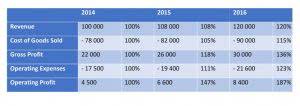Content
- Instagram Story Ads 101: Everything A Business Needs To Know
- Difference Between A Cash Flow And Other Financial Statements
- Statement Of Cash Flows Example
- Creating A Cash Flow Statement From Your Income Statement And Balance Sheet
- Is The Indirect Method Of The Cash Flow Statement Better Than The Direct Method?
- Direct Vs Indirect Cash Flow

It excludes all activities involving loans and equity injections, as well as cash receipts form the company’s operations in exchange for goods and services. If you attempt to construct the cash flow statement in the middle of an accounting period, you must reset the P&L accounts to zero, and in theory this is possible. The problem is that accountants will not have booked all relevant invoices and adjustments, so your accrual basis will not reflect the reality…. The indirect method uses changes in balance sheet accounts to modify the operating section of the cash flow statement from the accrual method to the cash method. The cash flow statement primarily centers on the sources and uses of cash by a company, and it is closely monitored by investors, creditors, and other stakeholders. It offers information on cash generated from various activities and depicts the effects of changes in asset and liability accounts on a company's cash position. Finance can reference both the balance sheet and the income statement while preparing a cash flow statement.
- The latest financial news, small business advice and updates on all things Nearside.
- Accrual accounting, which is when you record revenue and expenses at the time a transaction occurs, rather than when you actually lose or receive the money.
- Thus, if a company issues a bond to the public, the company receives cash financing.
- Investing activities include any sources and uses of cash from a company’s investments.
- For example, gains on sale of investments are reported as investing cash flow.
- The debit increases accounts receivable, which is then displayed on the balance sheet.
Net income from the income statement feeds into retained earnings on the balance sheet, and it is the starting point in the cash flow statement. The analyst can use common-size statement analysis for the cash flow statement. Two approaches to developing the common-size statements are the total cash inflows/total cash outflows method and the percentage of net revenues method. Cash basis financial statements were very common before accrual basis financial statements. The "flow of funds" statements of the past were cash flow statements. In 1979, FASB replaced the statement of changes in financial position with the statement of cash flows as a required financial statement. In doing so, FASB continued to permit some flexibility in reporting formats and made what some believe to be arbitrary decisions on the classification of cash flows.
Instagram Story Ads 101: Everything A Business Needs To Know
That means she has $67,500 in available cash to reinvest back into her business. Wave’s suite of products work seamlessly together, so you can effortlessly manage your business finances. We also allow you to split your payment across 2 separate credit card transactions or send a payment link email to another person on your behalf. If splitting your payment into 2 transactions, a minimum payment of $350 is required for the first transaction.
Unearned revenue, also known as deferred revenue, is a liability account that represents cash the company has received but not earned. This means increases in the account represent cash receipts that aren’t present on the income statement.
As you can see, I’ve highlighted asset accounts in blue, liabilities in red, and equity in green. You can see that the total balances of assets is equal to the total balance of liabilities + equity on both December 31, 2019 and December 31, 2020. Thereafter, we have a list of operating expenses including fulfillment, technology and content, marketing, and SG&A.
Difference Between A Cash Flow And Other Financial Statements
However, surveys indicate that nearly all large U.S. corporations use the indirect method. The non-cash expenses and losses must be added back in and the gains must be subtracted. Whether you choose to use the indirect or direct method will affect the way you operate your cash flow and the story you tell around it.

Here the values noted inside parentheses are negative, indicating outgoing cash. The Statement of Cash Flow is one of the main financial reports that companies produce at the end of each accounting period, along with the Balance Sheet, Income Statement and Statement of Changes in Equity. When the cash inflows and cash outflows are netted, the cash flow is arrived at. You can also use Shopify's cash flow calculator to easily calculate your cash flow and give your business a financial health check in less than five minutes. Keeping track of cash flow into and out of your business means you have a more holistic understanding of your business’s financial health. You can anticipate cash flow problems and solve them before they hit, and you can optimize your operations so cash flow troubles become a thing of the past.
The indirect method, on the other hand, starts with the net income and adjusts the profit/loss by the effects of the transactions. In the end, cash flows from the operating section will give the same result whether under the direct or indirect approach, however, the presentation will differ. The income statement and balance sheet have their own purposes, but the cash flow statement will give you the full picture on how cash, the most important account, is flowing through your business. Capital expenditures are the cash outflows for property and equipment. You can get a better reflection of the actual cash earned and spent by the business using operating cash flow and capital expenditures. When your cash flow statement shows a negative number at the bottom, that means you lost cash during the accounting period—you have negative cash flow. It’s important to remember that long-term, negative cash flow isn’t always a bad thing.
It reports the value of a business’s assets that are currently cash or can be converted into cash within a short period of time, commonly 90 days. Cash and cash equivalents include currency, petty cash, bank accounts, and other highly liquid, short-term investments. Examples of cash equivalents include commercial paper, Treasury bills, and short-term government bonds with a maturity of three months or less.
Statement Of Cash Flows Example
Add or subtract from the net income noncash gains, losses or expenses, including depreciation, amortization, depletion, gains or losses from asset sales and losses from accounts receivable. Group all depreciation expenses (assets' reduced value over time) and use that total as your depreciation figure. Using the direct method, actual cash inflows and outflows are known amounts. The cash flow statement is reported in a straightforward manner, using cash payments and receipts. Changes in accounts receivable on the balance sheet from one accounting period to the next must be reflected in cash flow. If AR decreases, this implies that more cash has entered the company from customers paying off their credit accounts—the amount by which AR has decreased is then added to net earnings. Cash flow from financing activities measures cash flow between a company and its owners and creditors.
Cash Flow Statement: Explained - Seeking Alpha
Cash Flow Statement: Explained.
Posted: Thu, 10 Feb 2022 08:00:00 GMT [source]
The cash flow statement makes adjustments to the information recorded on your income statement, so you see your net cash flow—the precise amount of cash you have on hand for that time period. There is an indirect and a direct method for calculating cash flows from operating activities. Prepaid insurance is a cash disbursement for coverage over the course of the year.
To construct the cash flow statement using the indirect method, we need to combine information from the P&L with the balance sheet (B/S). The start and finish dates on a CFS must correspond to the dates that accounting periods end. The reason why they must match is that we’re using net profit on the P&L as the base for our cash flows, and all accounts on the P&L are cleared to zero at the end of an accounting period. Because like the CFS, the P&L shows performance over a fixed period of time. The reason why we need the indirect method is a result of the accrual basis of accounting. Place the net income for the current financial period on the first line of the cash flow statement.
Creating A Cash Flow Statement From Your Income Statement And Balance Sheet
When adjusting the net income for cash gains and losses, subtract asset increases from the income and add asset decreases to the income. Investing activities include any sources and uses of cash from a company’s investments. A purchase or sale of an asset, loans made to vendors or received from customers, or any payments related to a merger or acquisition are included in this category. In short, changes in equipment, assets, or investments relate to cash from investing.
- For Example, if Accounts Receivable increases during the year - the company has sold more on credit during the year than it has collected in cash from customers.
- Our priority at The Blueprint is helping businesses find the best solutions to improve their bottom lines and make owners smarter, happier, and richer.
- Start bringing your financial data to life with Vena’s reporting solutions.
- Way holds a Master of Business Administration in finance from Central Michigan University and a Master of Accountancy from Golden Gate University in San Francisco.
- Both methods get the same result, but many accountants prefer the indirect method because they can prepare it more easily using information from existing financial documents.
Once you add the cash value for investing and financing activities, you can see the net cash increase or decrease. Non-cash items also count while calculating net income in an income statement or assets and liabilities in a balance sheet. Cash flow for non-cash items is calculated by adjusting the company’s net income based on differences in revenue, expenses, and credit over a time period. The differences used to make the adjustments are taken from two or more balance sheets and income statements.
Is The Indirect Method Of The Cash Flow Statement Better Than The Direct Method?
A full explanation is outside the scope of this article, but you can learn more about projections in articles on AnalystAnswers.com. List the starting and ending cash balances from the balance sheet’s assets. In other words, financing activities deal with loans and equity accounts. The difference lies in how the cash inflows and outflows are determined. As we have already discussed, the CFS is derived from the income statement and the balance sheet. Net earnings from the income statement are the figure from which the information on the CFS is deduced. In the case of a trading portfolio or an investment company, receipts from the sale of loans, debt, or equity instruments are also included because it is a business activity.
Pening nye indirect method cash flow 😩
— Ijam (@IzEzaimie) February 10, 2022
As an accountant for a small business, chances are that you feel pretty overworked as it is. Wouldn't it be nice if there were a way to just get the information you need for a cash flow statement, the measure of how money moves through an organization, straight from documents you already have around? Cash flow statements are a measure of how money circulates throughout an organization. Learn to use the indirect method to prepare a cash flow statement, including where to get and how to organize the necessary information.
Balance Sheet
While most accountants prefer using the indirect method for financial reporting, regulatory bodies are not in favor of this method given that it does not present a clear account of cash flows for a given period. An increase in the accounts payable, or any current liability account balance is added to net income. The wages payable balance increased because a larger accrual was made to represent wages owed at the end of 20X1 than 20X0. An increase in a current liability account balance means cash has not been paid and therefore, the $320 increase in the wages payable balance is added to net income.

FASB acknowledged that cash equivalents can be critical in an entity’s cash management, but their use did not justify the grouping of dissimilar assets. Accordingly, a future change by FASB excluding cash equivalents indirect method cash flow as part of cash may be forthcoming. The Cash Flow Statement Indirect method is used by most corporations, begins with a net income total and adjusts the total to reflect only cash received from operating activities.
You start with revenue and subtract out all expenses to discover what is left. Start by recording your net income for the reporting period in question. Calculating net income requires subtracting your business’s expenses, operating costs, and taxes from your total revenue. Greg purchased $5,000 of equipment during this accounting period, so he spent $5,000 of cash on investing activities. That’s a liability on the balance sheet, but the cash wasn’t actually paid out for those expenses, so we add them back to cash as well. With the indirect method, you look at the transactions recorded on your income statement, then reverse some of them in order to see your working capital. You’re selectively backtracking your income statement in order to eliminate transactions that don’t show the movement of cash.

If you sell off a large asset, your free cash flow would go way up—but that doesn’t reflect typical cash flow for your business. When you need a better idea of typical cash flow for your business, you want to use the operating cash flow formula. The direct method of preparing a cash flow statement results in a more easily understood report. The indirect method is almost universally used, because FAS 95 requires a supplementary report similar to the indirect method if a company chooses to use the direct method. Entities often have amounts of cash and cash equivalents that are restricted and reported elsewhere in the statement of financial position.